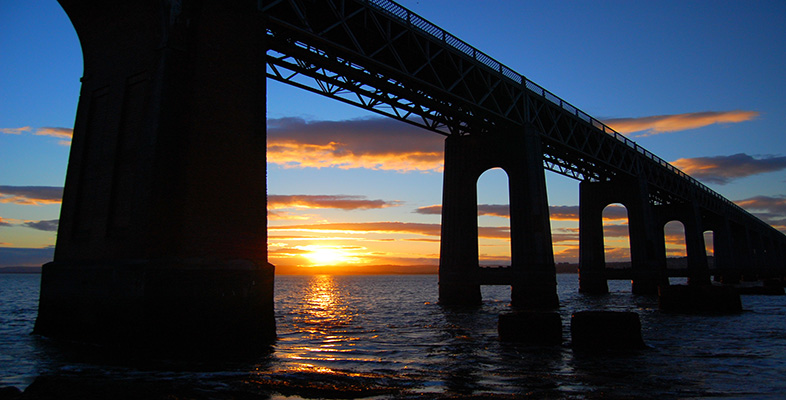5.11 Further evidence on stability
Given the importance of establishing the nature of the stability of the bridge, further witnesses were called at a later stage in the enquiry to shed some light on the problem. If Mr Noble had observed chattering of the joints in the tie bars, had similar phenomena been observed earlier?
The key witnesses were the engineers in charge of erecting and finalising the structure before it was opened in May 1878, Major-general Hutchinson, the BoT inspector who approved the structure for public use and others who inspected the bridge after it had been opened for traffic.
One key witness was Mr Macbeath, the inspector of the ironwork appointed by Bouch. He examined all the piers for two months before the bridge was inspected independently by Major-general Hutchinson in February, 1877, as well as for three months after approval had been given for public use. He said in his examination-in-chief that in his first overhaul, he examined every strut and tie bar in the bridge, tightening all bolts and gib and cotter joints. He found many loose joints and bolts, but they varied from pier to pier, with just two in some but ten in another. When cross-examined about any noise made by the structure, he denied hearing chattering of any joints, but his answer was equivocal:
15,798. (The Commissioner) Mr Noble was asked ‘Did you discover whether any of the ironwork of the bridge was getting unstable or loose?’ His answer was, ‘In taking these soundings that I have spoken of, I noticed or heard a chattering of the bars’. During the five months you were there, and during the three months subsequent to the inspection, you observed and you heard no chattering at all? – No, unless it was with the wind; the wind would chatter those bars, though they were as tight as fiddle strings.
15,799. If they were as tight as fiddle strings, they would not be required to be tightened up? – No.
15,800. The chattering would have been of no importance at all? – No, unless they were really loose.
The next witness examined was Frederick Reeves, an assistant to Groethe, the manager of the bridge project. He checked the construction of the piers during their erection, and was asked by Gilkes, who was in charge of the contractors, to inspect the structure in late 1877. He ensured all the bolts and joints were tightened. His team of fitters examined every joint to ensure they were tight. They checked the tie bars by striking them with a hammer, the note emitted presumably rising with the degree of tension. He was asked about the chattering of the joints:
15,874. I will ask you a question which was put by Court to the last witness. You have heard the expression used in this room that there was a chattering of the bars together, or some sound coming from the piers resembling rattling? – Yes.
15,875. Were trains passing over the bridge during the last two months? – Yes, ballast trains.
15,876. How frequently? – As frequently, I think as four trains a day or five trains a day.
15,877. Did you ever hear during the time, before you left the bridge, anything that you would understand by a chattering of any parts of the ironwork? – Yes.
15,878. When was that? – Before the bars were perfectly tightened.
The witness was referring to his service on the bridge during December 1877, his contact terminating exactly two years before the accident, on 28 December 1877. His testimony continued in re-examination:
15,942. You said that before you tightened it up you did hear a chattering of the ties, did you not? – Yes.
15,943. But when you left it in December you heard none? – I never heard any of these bars vibrating, or chattering, as it is called, after they were properly tightened. I have been down in different parts of the pier when trains have been passing, and my attention was particularly called to that, because I heard them chattering on a previous occasion.
So the phenomenon had been heard when the bridge had just been finished in late 1877, but disappeared when the joints were fully tightened. This was confirmed by Major-general Hutchinson, who studied the behaviour of the structure under worst loading conditions. For three days starting on 25 February 1878, he tested the bridge by running no less than six new goods locomotives across the bridge, with a total weight of 438 tons. He ran them at a top speed of 40 mph, and observed for any movement with a theodolite. As a result he measured a maximum deflection in the longest girders of about an inch, and said,
The lateral oscillation … was very slight, and the structure altogether showed great stiffness.
In cross-examination, he added that he actually climbed up into one of the piers of the high girders and held onto the columns and braces as the six trains passed overhead. There could not have been a better test of the vibrations in the structure from overloading.
He added a caveat about wishing to observe the effect of high winds on the bridge, but never came to check for this important property. He also recommended the speed limit of 25 mph, although it seems clear from the eye-witness evidence it was not always obeyed. Perhaps history might have been different if Hutchinson had tested the bridge at a later stage, because Noble first noticed renewed chattering only four months after the official opening in May 1878. Noble fitted the first iron shims to loosened joints in October 1878.
